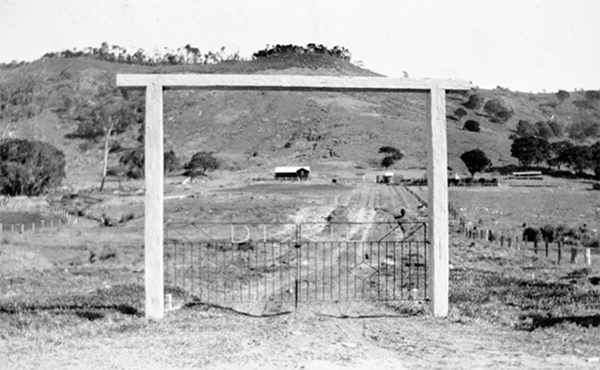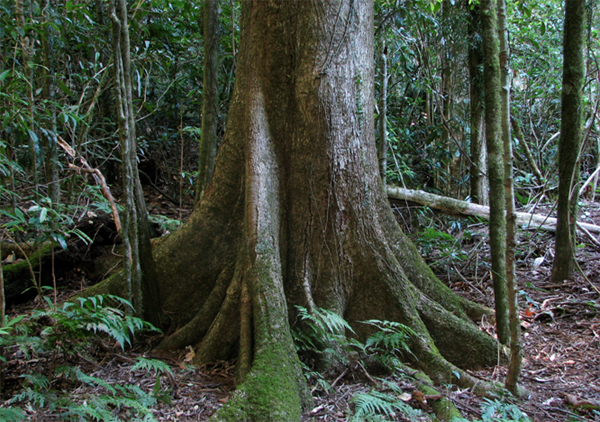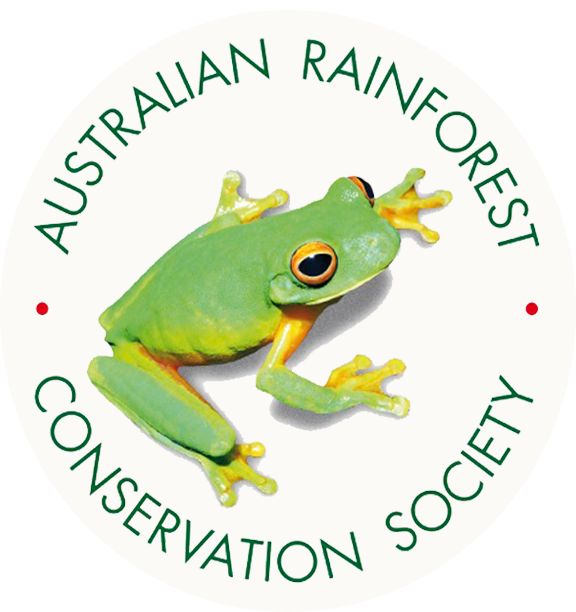Background
Springbrook Rescue is a 10- to 20-year project with overall aim of restoring rainforest on cleared areas and re-creating links between sections of the national park, thus creating a more viable World Heritage Area and one which provides a greater potential for its flora, fauna, fungi and other organisms, especially ancient lineages underlying criteria for listing, to survive the impacts of human-caused climate change.
The Australian Rainforest Conservation Society accepted responsibility for managing, pro bono, the restoration program for properties purchased by the Queensland Government. The over-riding context is one of restoring World Heritage values and integrity with a focus on a whole catchment approach where possible.
Springbrook acts as a critical refugium especially for ancient lineages of plants and animals that would not otherwise survive modern day conditions. It is fundamentally important to expand the area of rainforest with its closed canopy and to repair canopy gaps created by unnecessarily wide roads, thus sealing in moister and cooler microclimates more akin to ancient palaeoclimates under which ancient lineages evolved.
To be successful, a specific Program Logic was developed with clear long-term aspirational goals and explicit short-, intermediate- and longer-term objectives indicating the practical pathway by which those goals could be achieved. The objectives allow specific, measurable, achievable and realistic time-bound milestones or outcomes allowing transparent monitoring and review of progress with the possibility of improvements where results indicate the need. The Program Logic is described in more detail in the foundation Restoration Report (p. 27).
Restoration Goals
- An expanded, protected and self-sustaining World Heritage area that provides secure and viable habitat for flora and fauna of outstanding universal value, that functions and looks as it did historically before it was disturbed, and is able to resist or recover from climate change and other impacts
- A Case Study of scientifically based ecological restoration, primarily through assisted natural regeneration, that provides generic principles and guidelines within a decision framework for effective and efficient restoration at ecologically meaningful scales
Restoration Objectives
These more specific objectives document how the broad aspirational goals can be met and progress towards meeting them progressively monitored. They are based on the nine attributes of restored ecosystems in SER’s Primer on Ecological Restoration (2004) and in IUCN’s Ecological Restoration for Protected Areas: Principles, Guidelines and Best Practices (2012). An additional objective (3) relates to recovery of critical habitat.
Goal 1 Objectives:
- Community composition, structure and function matches those in reference systems of similar age
- Only indigenous species are present
- Habitats for rare, threatened and significant species are adequate and viable
- All functional groups necessary for continued development, stability and resilience are present or able to colonize naturally
- The abiotic environment is able to sustain reproductively viable populations
- Ecosystem functions are normal for each stage of ecological development
- Landscape integrity enables normal abiotic and biotic flows and exchanges
- Threats to ecosystem health and integrity are absent or controlled
- Resilience and stability mitigate against normal disturbance regimes and stresses from climate change
- The ecosystem is self sustaining but allows for ongoing evolution
Goal 2 Objectives:
To acquire, document and disseminate information on rainforest restoration in order to facilitate more cost-effective restoration at ecologically meaningful scales |
- The decision framework integrates ongoing review and improvement of goals, objectives, and resource requirements within socio-economic and ecological contexts, with feedback from risk assessment and monitoring of outcomes from targeted interventions.
- All activities are documented, timed and costed for comparative evaluation and upscaling
- Results are published widely through web links, social media and scientific journals
- The project is an informative Case Study revealing new insights into cost-effective ecological restoration
Foundation Principles:
- Only do what nature needs
Natural regeneration should only be assisted if existing abiotic or biotic barriers prevent normal successional processes, or recovery of critical habitat is urgently required to prevent ongoing decline or extinction of species’ populations.
This principle means one has to understand and work with nature according to its timeframes and processes, and identify what factors resulted in the present situation.
- Use conceptual models of ecological function and dynamics to guide interventions.
Always think in terms of ecosystem processes — weeding is a “disturbance” that affects productivity, species interactions and feedback loops — and the possibility of tipping points
-
Adopt a social-ecological systems approach at scales that matter
- Match timeframes to ecological needs
At least 10–20 years will be necessary where restoration involves abandoned pastures
Security issues become paramount for such long timeframes and legal frameworks underpinning security are essential
- Match resources to timeframes to ensure project sustainability
- Use the most efficient means capable of scaling up to larger scales
Always think “what would this cost if I had to scale it up to many or hundreds of hectares; “is there another equally effective more efficient way?”
- Community support is essential for sustainable outcomes
These principles will be continually reviewed throughout the project for their relevance and sufficiency.
 A view from Springbrook Rd in the 1940s looking up towards the ridge behind Koonjewarre (then Dixie Farm) showing almost complete clearing
soon after original settlement in 1906 and remaining so until at least 1975. Koonjewarre is one of the Springbrook Rescue properties
A view from Springbrook Rd in the 1940s looking up towards the ridge behind Koonjewarre (then Dixie Farm) showing almost complete clearing
soon after original settlement in 1906 and remaining so until at least 1975. Koonjewarre is one of the Springbrook Rescue properties.
 Our goal is to restore critical habitat and landscape connectivity, especially in the most vulnerable high country,
ultimately to something like their original condition as depicted in the above reference site.
Our goal is to restore critical habitat and landscape connectivity, especially in the most vulnerable high country,
ultimately to something like their original condition as depicted in the above reference site.
|
 Springbrook Rescue
Springbrook Rescue
 Springbrook Rescue
Springbrook Rescue